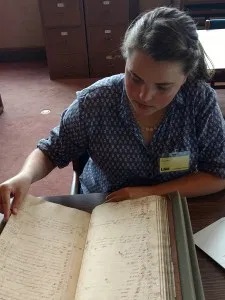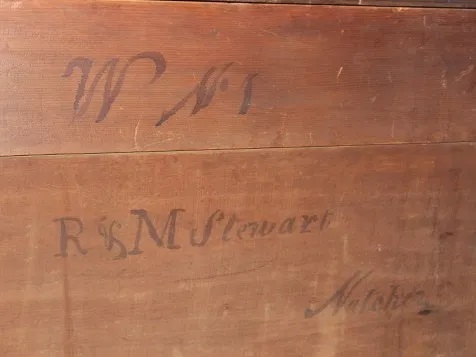Summer Research Report: Candice Candeto

Candice Candeto reading Robert Stewart’s business ledger at LSU’s Hill Memorial Library.
The summer of 2017 has been a particularly exciting one for the Trust. We welcomed new full-time staff member Kristina Gray as Membership Coordinator while Programming and Communications Coordinator Christian overdosed on historic houses during the Attingham Summer School. Matt kept the home fires burning with every appearance of serenity. On top of these developments, we awarded a bumper crop of Summer Research Grants, and the reports detailing our scholar’s exciting discoveries are starting to come in!
Candice Roland Candeto, a second-year fellow with the University of Delaware’s Winterthur Program in American Material Culture, enjoyed a particularly fruitful summer in Louisiana and Mississippi. An alumna of the University of Mary Washington, where she studied Historic Preservation and Museum Studies, Candice has worked at the James Monroe Museum, the George Washington Foundation, Thomas Jefferson’s Monticello, and, most recently, the research library of the Virginia Historical Society. She has always been interested in the complex history of the American south, and during her time at Winterthur has come to value the ability of decorative arts and material culture to honestly speak to the worldview of their owners and makers in ways that may not be reflected in the written records.
With assistance from the Decorative Arts Trust, Candice was able to conduct field work on the cabinet maker Robert Stewart, the focus of her master’s thesis. Stewart was a Northern-born craftsman who worked in Natchez, MS, the wealthiest city in America in 1850, and one where a third of the population was enslaved, a quarter foreign-born, and hundreds more lived as free people of color. Stewart’s clientele encompassed all these social, economic, and racial categories. Examples of his work survives in public and private collections, and some of the latter have stayed in place since the mid-19th century.
“I began my summer research at the Louisiana State University and Tulane University, where I spent a week examining Stewart’s account books. This provided a strong documentary foundation for interpreting the furniture I saw in Natchez. Once in Mississippi, I worked closely with Mimi Miller, Executive Director of the Historic Natchez Foundation, whose decades of research and outreach literally opened doors for me to closely study Stewart pieces in public and private collections.
Candice measuring a tool chest in a private Stewart family collection. The box has an inventory of tools inside and likely belonged to Robert’s son who worked with his father and took over the business by 1861.
“Among my more exciting finds was a chest of drawers in a private Stewart family collection which is signed ‘R. & M. Stewart, Natchez.’ The reference to Stewart’s partnership with his brother Miller allowed me to date this piece to before 1835. The chest’s ornately carved columns raise interesting questions of the level of work Stewart was producing in his shop, rather than importing and retailing, and the influences from urban centers that appear in his Mississippi-made furniture.
“Taking entries from the Stewart account books, I attempted to match archival evidence to extant furniture in some of the many Natchez houses with original furnishings. This rare and exciting opportunity led me to a dining table, today in the private collection, with a likely history of ownership by Stewart’s client William Harris. The table’s cherry top is consistent with Mississippi manufacture, but the two distinct styles of turnings on the legs speak to the complex nature of much of Stewart’s furniture. Did the Stewart use a combination of locally made, plainly turned legs and imported twist-turned legs, creating a custom piece to fit a large double parlor? Further research into this fascinating piece will shed light on the nature of furniture production in antebellum Mississippi and connections between this region and the rest of the Atlantic world.
“As I continue to analyze the archival and material evidence gathered this summer, I hope to better understand the ways in which Stewart’s furniture speaks to the evolving social and economic systems of a widely connected and wealthy Southern town on the eve of the Civil War. My time in the Gulf South was incredibly profitable, and I am deeply grateful for the Trust’s contribution making it possible.”
We are excited by Candice’s discoveries and look forward to hearing about future conclusions. We also wish to thank the many generous donors who support the Summer Research Grant program.
About The Decorative Arts Trust Bulletin
Formerly known as the "blog,” the Bulletin features new research and scholarship, travelogues, book reviews, and museum and gallery exhibitions. The Bulletin complements The Magazine of the Decorative Arts Trust, our biannual members publication.









